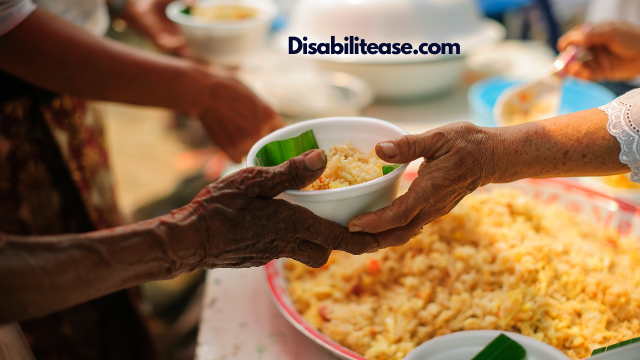What food helps Parkinson’s disease? Let’s get to know. Parkinson’s is a disease of the nervous system of the body. It occurs when nerve cells in a specific part of the brain specifically in the substantia nigra deteriorate and dopamine production is hindered.
Dopamine is a neurochemical performing different functions, one of which is controlling movements. Dopamine acts as a chemical messenger that helps in the communication of different brain parts.

Maintaining a proper balance with other neurotransmitters coordinates the nerve and muscle cells to carry out body movements.
Here is a related article that might interest you on How Does Parkinson’s Disease Begin?
If the neurons of the substantial nigra are damaged, the amount of dopamine is lowered, which disturbs the balance of neurotransmitters, causing a loss of the capacity to regulate bodily movements.
The reason for this death of dopamine-producing neurons of substantia nigra is mainly unknown.
A healthy diet is vital to lower the risk of Parkinson’s disease. Plus, good dietary patterns can also boost your ability to minimize the symptoms.
Table of Contents
What Food Help Parkinson’s Disease? Is It Deadly?
Parkinson’s disease is one of the fastest spreading diseases affecting approximately 1 million people in the United States and almost 10 million worldwide. Although anyone can have
Parkinson’s disease, research shows that men are more affected than women. The reason for this vulnerability of men more than women is still unknown and under study. The natural aging process, genes, and environment are significant factors inducing the disease.
Often the disease is diagnosed when almost 80% of the dopamine production is reduced. Then the symptoms of the disease, like limb rigidity, loss of unconscious movements, tremors at rest, a sense of imbalance, slowed movement, etc., appear.
Medications, self-care, and surgery can significantly manage the symptoms but it is impossible to completely cure Parkinson’s disease.
What Are The Symptoms Of Parkinson’s Disease?
Parkinson’s disease is a slowly progressing disorder that worsens day by day with passing age. It is essential to mention that when the disease is diagnosed, almost 80% of dopamine production is already diminished due to the deterioration of neurons in the substantia nigra.
Scientists are hardly trying to find ways through which the progression of the disease is slowed down and also it can be diagnosed early.
The symptoms of the disease significantly differ from person to person. Plus, they are slowly developing with age. The symptoms may be categorized into two groups as discussed below:
Motor symptoms:
As the name indicates, motor symptoms are related to movements.
- The most observable motor symptom includes the involuntary movement of hands, arms, jaws, legs, and feet. These irritating spontaneous movements are known as tremors.
- These tremors are not jerky or random; they are slow and continuous. Another significant symptom is the rigidity in muscles, due to which the muscles become hard and stiff, causing pain and hindering movement.
- Moreover, bradykinesia is a significant motor symptom of Parkinson’s disease, which causes routine movements like walking, getting out of bed, etc., to be extremely slow.
- Plus, it reduces the facial expressions, and the face looks abnormally still. Moreover, voluntary movements like blinking eyelids and moving your arm while walking are also reduced. Furthermore, stooped posture, repetitive twisting of muscles, impaired coordination, and troublesome balance are also seen in Parkinson’s patients.
Non-motor Symptoms:
Generally, it is thought that Parkinson’s disease is only associated with movements, but this is not true. Many other health issues are caused due to it and are known as non-motor symptoms as they have no relation to movement.
These symptoms are not visible to others but can cause more trouble than motor symptoms. Many of these start even before the diagnosis of the disease. Frequent constipation is a sign that has a strong link with the disease.
It affects a person’s senses like smell and taste. In addition, a gentle sleep cycle is also disturbed. Moreover, weight loss, fatigue, sexual problems, hallucinations, excessive sweating, problems in intellectual activities, an increase in dandruff, mood swings, and visual impairments are also observed in different patients. As already mentioned, symptoms vary in different patients.
What Are The Main Risk Factors And Causes Of Parkinson’s Disease?
Primarily, the disease starts after the 60s, but the onset may be after the 50s or even before. The reason for this disease occurring at a young age is often genetic or family history, but it is unnecessary in all cases. The exact cause of the reduction of dopamine due to nerve cell death in a specific brain area is not entirely known.

But, it is considered that a fusion of genetic and environmental factors along with lifestyle are the major contributing factors to the disease. The contributing percentage of each factor varies significantly in different people.
Age is the foremost risk factor for the onset of disease. Young adults rarely suffer from the diseases, but if it occurs before the 60s, they may result from some gene mutations. Studies reveal that nearly 10-15% of Parkinson’s cases are caused due to genetics.
After analyzing the DNA of several patients, scientists concluded that several gene mutations were seen. These mutations are inherited from one ancestor to their offspring.
The interaction of genes with the environment is complex because some environmental factors increase the chances of disease while others may lower the risk of suffering from the disease. Any severe head injury may increase the chances of the disease. Plus, exposure to heavy metals and pesticides are found to be strong links causing the disease.
What are the treatments for managing Parkinson’s disease?
Parkinson’s disease is currently incurable, but it is easily possible to live a quality life even after the onset of the disease. This disorder is currently incurable; treatment can only manage the symptoms. Also, no standard treatment is available, and it depends on the patient’s condition.
Medication and surgeries are practiced for managing disease, but none of them can reverse the effect of the disease. Moreover, a healthy lifestyle comprising a healthy diet and exercise can also help the disease.
Medications can help increase the dopamine production of the brain and aid in controlling non-motor symptoms. Levodopa, Amantadine, and Dopamine agonists are mainly used to treat Parkinson’s disease.
Patients who do not get a beneficial effect of medication are recommended to have surgery. During the surgery, the doctor puts a small electrical device in the chest region and connects electrodes implanted in the brain—these help in controlling the motor symptoms of Parkinson’s disease by stimulating specific brain areas.
What Food can help Parkinson’s disease?
A healthy diet is vital to lower the risk of Parkinson’s disease. Plus, good dietary patterns can also boost your ability to minimize the symptoms.
Research shows that people with Parkinson’s disease may have varying deficiencies of specific nutrients according to the condition. We will discuss a detailed overview of the foods you should be aware of to avoid or slow down the progression of Parkinson’s disease:
Whole-grain bread:
Whole-grain bread comprises less processed flour formed from fully intact grains. As the entire grain remains within the bread, it is highly rich in proteins, fibers, B vitamins (B1, B2, B3, and B9), and nutrients like iron, magnesium, etc. It is a perfect choice for decreasing the risk and managing the symptoms of many diseases, including Parkinson’s disease.
Constipation is one of the main problems for patients with Parkinson’s disease. The whole-grain bread is rich in fibers, so it helps combat constipation.
Plus, vitamins, especially B1 (Thiamin), B2 (Riboflavin), and B3 (Niacin), keeps the nervous system healthy, so they help lower the risk of disease in addition to minimizing the symptoms.
Whole-grain bread also contains vitamin B9 (Folate) and iron, which are helpful to balance the hemoglobin level in RBCs (Red Blood Cells). The deficiency of hemoglobin has been identified to enhance the risk of Parkinson’s disease.
Fava Beans:
Levodopa is the most effective medicine for Parkinson’s patients. Fava beans are a rich source of levodopa, and all plant parts contain this substance, i.e., leaves, stems, pods, and beans. It is an amino acid and precursor of dopamine, a neurochemical deficiency in Parkinson’s patients.
So, it is believed that consuming fava beans increases motor performance and thus is a choice for many patients. But, they should not be taken as an alternative to medicine. Also, please don’t use them alone; discuss them with your doctor before using them.
Fish Oil:
Parkinson’s disease occurs due to nerve cell death in the brain area (substantia nigra), which reduces dopamine. Studies have also shown that neuroinflammation also significantly contributes to causing the disease. Seafood and fish oil are rich in omega-3 fatty acids and polyunsaturated fatty acids (PAFs).
Omega-3 fatty acids are inflammatory mediators’ precursors, thus protecting against neuroinflammation. Plus, it also helps in improving neurotransmission and slows down neurodegeneration. Salmon, oysters, and anchovies are a few examples of fish and seafood high in omega-3 fatty acids.
Antioxidant-rich Food:
Free radicals are oxygen-containing molecules that are very reactive and unstable. They are synthesized as a byproduct of metabolism in the body. They are naturally present in the body, and also their production can be increased by smoking, pollution, radiation, etc.
In the human body, free radicals exist in a balance, but if this balance is disturbed, an excessive amount of free radicals accumulate in the body. These free radicals have unpaired electrons, which unnecessarily react with other molecules destroying cells.
These excessive free radicals create oxidative stress. Studies have revealed that oxidative stress is a likely cause of disease.
Antioxidants are substances that give protection against the destruction of cells caused by free radicals. They do so by giving their electrons to stabilize the free radicals. It is straightforward to get these defenders of free radicals through diet.
Many simple food products are potential reservoirs of antioxidants. For example, citrus fruits (orange, lemon, etc.), grapes, strawberries, blueberries, raspberries, walnuts, turmeric, spinach, broccoli, kidney beans, cocoa products, etc., are rich in antioxidants.
Food rich in Vitamins:
Many vitamins contain antioxidant properties. Patients who have Parkinson’s disease are deficient in one or more vitamins. They can be taken in the form of supplements. But maintaining a healthy diet that contains all the necessary vitamins is the best way of their intake.
The vitamins essential in this regard are Vitamin B12, Vitamin B9 (Folate), Vitamin C, Vitamin D, and Vitamin E.
Vitamin B12 has antioxidant properties and protects against oxidative stress. Plus, it keeps the nervous system and RBCs properly working. A reduced level of B12 hinders the motor functions of the brain. Moreover, it is observed that patients using levodopa have an increased amount of amino acid, homocysteine, in their bodies. This amino acid causes cognitive disorders. This amino acid is metabolized by Vitamin B12, improving the symptoms.
Thus, to avoid or control Parkinson’s disease, a diet containing this vitamin should be consumed. The foods having vitamin B12 are eggs, chicken, red meat, cereals, yeast, etc.
Vitamin B9 (Folate) performs many essential brain and body functions. It helps keep the hemoglobin (pigment that carries oxygen) level balanced in RBCs. The deficiency of hemoglobin may contribute to enhancing the severity of the disease. In addition, vitamin B9 is also involved in metabolizing homocysteine.
Food items rich in folate are green leafy vegetables (e.g., spinach, turnip, lettuce, and broccoli), liver, kidney meat, yeast, etc.
Vitamin C and Vitamin E minimize the risk of disease by approximately 32%. Vitamin C is an antioxidant and helps to reduce free radicals damage.
Foods with a large amount of vitamin C include citrus fruits, strawberries, vegetables like spinach, bell peppers, potatoes, tomatoes, etc. Vitamin E also has antioxidant properties in nuts and seeds, leafy green vegetables, vegetable oils, avocados, etc.
Vitamin D
Research shows that people with high vitamin D level has a 65% less chance of Parkinson’s disease. The deficiency causes non-motor symptoms like cognition as well as different mood swings in the individuals suffering from the disease.
Another post that will interest you is about the Best Computers, Tablets, And Mouses For Parkinson’s Patients.
So, taking this vitamin in our diet is essential to remain healthy. Food items having vitamin D are red meat, certain fortified foods, egg yolks, fish oil, beef liver, etc.
A lot of many other food items may help in managing or avoiding the disease. A healthy diet is the secret to a healthy life. So, you must be careful with the stuff you are nourishing your body.
And unfortunately, if you are suffering from the disease, consult your physicians before going for any supplements, medication, food, or another remedy. Stay healthy, Stay safe.

Hi, my name is Eddie, I am a professional trainer specializing in the elderly population and I’m also a website designer. I love training in the gym, going to the beach, traveling, and having good food.
I combined my love for sport and website designing to make “DisabilitEase” whose purpose is to help elderly and disabled people live a more full and active life, have more fun, and enjoy their unique journey despite any disability.



